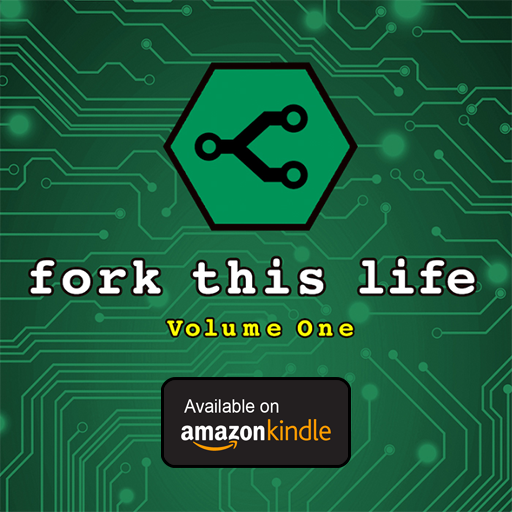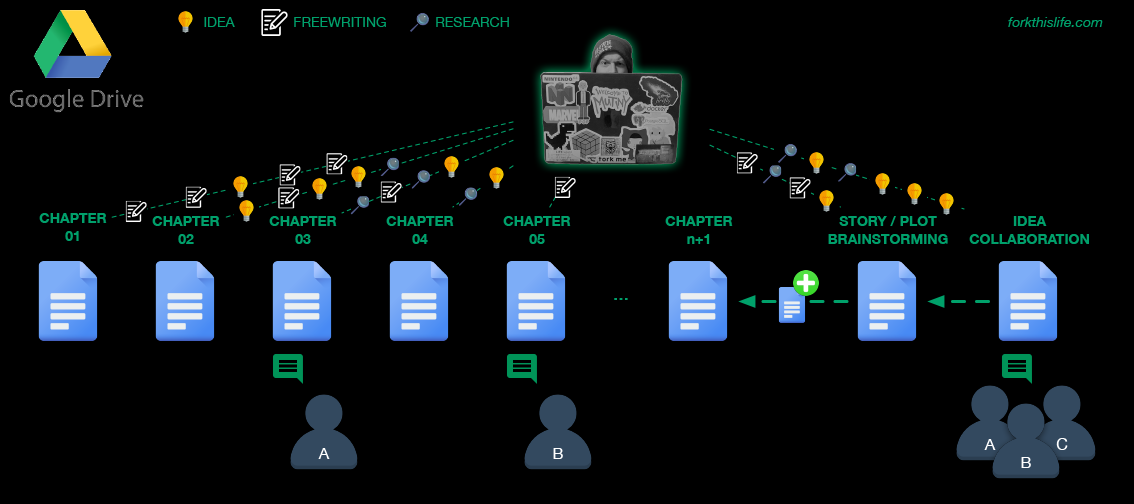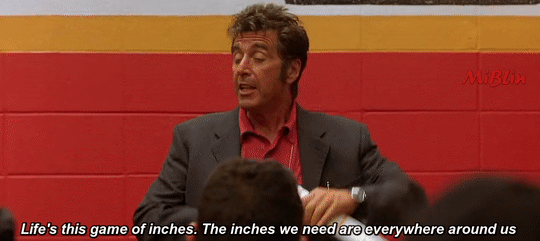Hacking My First Fiction Novel - 2/3
 After reading Part 1 of this series, we can now focus on the most challenging and demanding phase in this process: writing. By far the most difficult part of writing fork this life : Volume One was the constant search for motivation to pursue an end-goal that seemed to fluctuate between being far off in the distance or deceivingly just beyond my reach. A close second was the struggle of taking the multi-threaded chaos living inside my head and converting it into coherent thoughts and sentences. It took me a few weeks of sticking and unsticking myself from the mental mud to realize that I needed a different approach if I was ever going to finish.
After reading Part 1 of this series, we can now focus on the most challenging and demanding phase in this process: writing. By far the most difficult part of writing fork this life : Volume One was the constant search for motivation to pursue an end-goal that seemed to fluctuate between being far off in the distance or deceivingly just beyond my reach. A close second was the struggle of taking the multi-threaded chaos living inside my head and converting it into coherent thoughts and sentences. It took me a few weeks of sticking and unsticking myself from the mental mud to realize that I needed a different approach if I was ever going to finish.
Phase 2: Writing
Below are some tips and tricks I used to build up momentum and keep this part of the project moving along.
Recognizing Times to Write
Finding time to write is a constant struggle. When I first started the whole process, I believed that "blocking time to write" required blocking off multiple hours where I could focus. As a husband, father of two rambunctious daughters, technology professional and a constant juggler of chaos, finding multiple hours quickly became a daunting and depressing task. My most common large block of productive writing time occurred between 10PM and 2AM, but there is a physical limit to how many of these evenings one can string together, especially in a row. I tried various productivity hacks like Brain.fm, which seemed to work for a bit but it was too random and subtle for my tastes (see, below). Eventually, I leaned back on my preparation work and outline documents.

There was a lot of work to be done, but it wasn’t always the same: Research. Brainstorming. Writing. Each "work type" had a different mindset and time commitment. Research and Brainstorming were the easiest by far to pick up transactionally, and in some cases could be automatically recorded into my brainstorming outline with some simple IFTTT append recipes, emails or iOS shortcuts. If a miraculous 15 minutes became available, I followed a standard plan, every time. I’d start with my next chapter and go through the different types of work needed to prepare for the larger Writing effort. This is where Google Docs and inline TODO’s and commentary became invaluable, as I could skip around and leave myself notes and/or ask trusted friends their thoughts without divulging too much of the story. The biggest issue with Google Docs is the ~1 million character limit and sluggish UX for larger files, but the Google Docs Offline Extension helped minimize most of those performance issues. In a way, these "limitations" work perfectly to help you break up your work into the outline framework mentioned above. In Part 3, I’ll show you how I stitched everything back together.
When it came time to actually write, I had all the relevant research, ideas and outline in front of me. Over the course of two and a half years, I claimed well over 100 hours of 15 minute sessions. In short: make the most of the time you have … the minutes we need are everywhere around us … you just have to work with them rather than against them.

Your Mood Matters
There’s a difference between wanting to write and feeling like you want to write. I can’t count the number of days I sat down and my heart just wasn’t in it. I’d type a sentence and delete it, or fall victim to a "five minute" *cough* "thirty minute" *cough* video game distraction … or even worse, doom scrolling on social media. I consider these times a classic "square peg round hole" scenario. This is where the preparation work paid off even further. I knew my story. I knew the general plot, and how I thought I wanted my characters to interact. Before I started to write, I took a few minutes to do an internal sanity check of my mental state. How was I feeling? Happy? Sad? Tired? And, if I was feeling willing and ready to write, I tried to focus on the next chapter in the queue. When it comes to writing, sequential progress beats sporadic progress, in my opinion.
On the rare days where everything was in alignment, I didn’t want to waste a good thing. So, I would jump to a section in the book that best matched my overall mood. In some cases, this meant just brainstorming and freewriting sentences, paragraphs or even pages at a time into the appropriate Google Doc. When I felt the spark start to dwindle, I’d pivot back to either the standard "next chapter" or try different work modes to salvage what was left of my time. The hardest skill to master here is quickly recognizing when you are stuck or knowing when your heart just isn’t into it.
If you can take the time before you start your endeavor to understand your own emotional signals, it will pay dividends down the road. This is how the fork this life : Volume One Soundtrack came into existence. I frequently use music to calibrate my emotional state when I work on big projects. When I find a song that resonates a desired feeling/rhythm, I play it in the background on endless repeat. If I need to bring my mind back into focus on that section, I simply closed my eyes and played the song a few times to prime the creative pump. This is a productivity hack I resurrected from college, where I used vastly different genres of music for each class when studying for tests. My apologies go out to my roommates who may never hear the Rudy Soundtrack again without a distressed eye twitch.
Hold Yourself Accountable
Impatience is a gnarly by-product of the always on hustle of modern connected culture. For anyone who is passionate about their work, nothing hurts more than the self-induced body blows of expectation. It’s an easy feeling to try and avoid, but with a little dedication it’s an easy feeling to manage. It all starts with holding yourself accountable with realistic and attainable goals. This is where breaking up your story arch into sections, chapters and the Google Docs comes into play. I used Trello (Free) and the templated task list feature to create some "movable" cards I could pull in and out of focus. From there, I made weekly goals in Trello Tasks, never daily, and set monthly milestones to reach certain readiness aspects for each document. Note: Just about any modern task management solution would work with this framework, I’ve just always been a Trello fan. As you get going, a rhythm should arise as your blank structure begins to take shape. Once cards start flying off your queue and task lists start showing 100% Complete, there is a palpable momentum that can compel you to keep moving. Also, take time to appreciate the goals and progress along the way. It’s just as important to see how far you’ve come than how much farther is yet to go.
Hack Tip:
If it’s your thing, become socially accountable and share your milestones with people outside of your immediate circle, such as the Fork This Life Facebook Page. The external motivation is helpful to keep your goal setting realistic. If possible, adopt a hashtag to chronicle the journey as it’s a great way to reflect. For example, I chose #JustKeepWriting.
Stay tuned for the final part three of this short series coming this month. In the mean time, please consider following / sharing content from @ForkThisLife or Facebook and check out my book on Amazon Kindle and Paperback. Until then, #JustKeepWriting.
– RR